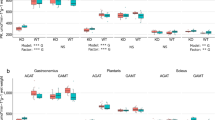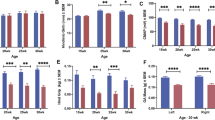Abstract
DIRECT oxidation of glucose-6-phosphate through the pentose phosphate pathway is known to occur in various animal tissues. The enzymes glucose-6-phosphate dehydrogenase (G6PDH) and 6-phosphogluconate dehydrogenase (6PGDH), which are involved in the first two steps of this pathway, have been found in many organs. The activity of these enzymes in skeletal muscle is exceptionally low compared with that of most other mammalian tissues studied1. Their activity does, however, increase in muscles undergoing atrophy. This increase appears to be relatively unspecific, as it has been observed in denervation atrophy, hereditary muscular dystrophy, muscle necrosis due to trauma or viral infection, and in myopathy induced by drugs2–4. We have studied the G6PDH and 6PGDH activity in normal and denervated soleus and gastrocnemius muscles of the rabbit. Our findings suggest that the increase in activity of these enzymes may be the result, not of specific changes in the muscle cell itself, but rather a reflexion of the increase in connective tissue.
This is a preview of subscription content, access via your institution
Access options
Subscribe to this journal
Receive 51 print issues and online access
$199.00 per year
only $3.90 per issue
Buy this article
- Purchase on Springer Link
- Instant access to full article PDF
Prices may be subject to local taxes which are calculated during checkout
Similar content being viewed by others
References
Glock, G. E., and McLean, P., Biochem. J., 56, 171 (1954).
McCaman, M. W., Amer. J. Physiol., 205, 897 (1963).
Pennington, R. J., Biochem. J., 88, 64 (1963).
Smith, B., J. Path. Bact., 89, 139 (1965).
Garcia-Buñuel, L., Garcia-Buñuel, V. M., Green, L., and Subin, D. K., Neurology (Minneapolis), 16, 491 (1966).
Lowry, O. H., Roberts, N. R., Schulz, D. W., Clow, J. E., and Clark, J. R., J. Biol. Chem., 236, 2813 (1961).
Neuman, R. E., and Logan, M. A., J. Biol. Chem., 184, 299 (1950).
Martin, C. J., and Axelrod, A. E., Proc. Soc. Exp. Biol. and Med., 83, 461 (1953).
Woessner, J. F., and Boucek, R. J., J. Biol. Chem., 234, 3296 (1959).
Shonk, C. E., and Boxer, G. E., Cancer Res., 24, 709 (1964).
McCaman, M. W., and McCaman, R. E., Amer. J. Physiol., 209, 495 (1965).
Golarz, M. N., Bourne, G. H., and Richardson, H. D., J. Histochem. Cytochem., 9, 132 (1961).
Beckett, E. B., and Bourne, G. H., Science, 126, 357 (1957).
Beaconsfield, P., and Reading, H. W., Nature, 202, 464 (1964).
Hiatt, H. H., and Lareau, J., J. Biol. Chem., 235, 1241 (1960).
Chapman, J. A., J. Biophys. Biochem. Cytol., 9, 639 (1961).
Author information
Authors and Affiliations
Rights and permissions
About this article
Cite this article
GARCIA-BUÑUEL, L., GARCIA-BUÑUEL, V. Connective Tissue and the Pentose Phosphate Pathway in Normal and Denervated Muscle. Nature 213, 913–914 (1967). https://doi.org/10.1038/213913a0
Published:
Issue Date:
DOI: https://doi.org/10.1038/213913a0
This article is cited by
-
Additional biochemical criteria in the differential diagnosis of myositis
Journal of Neurology (1987)
-
Collagen of slow twitch and fast twitch muscle fibres in different types of rat skeletal muscle
European Journal of Applied Physiology and Occupational Physiology (1984)
-
The value of enzyme histochemical techniques in classifying fibre types of human skeletal muscle
Histochemistry (1976)
-
Duchenne muscular dystrophy and poliomyelitis
Journal of Neurology (1975)
-
Semipermeable membranes for improving the histochemical demonstration of enzyme activities in tissue sections
Histochemistry (1974)
Comments
By submitting a comment you agree to abide by our Terms and Community Guidelines. If you find something abusive or that does not comply with our terms or guidelines please flag it as inappropriate.



